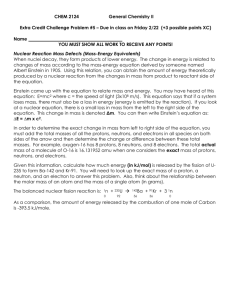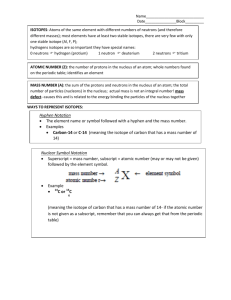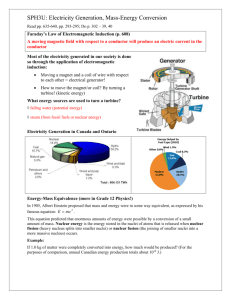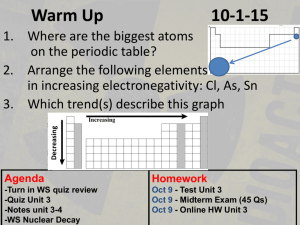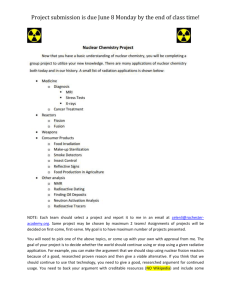ln (2) - Liberty Union High School District
advertisement
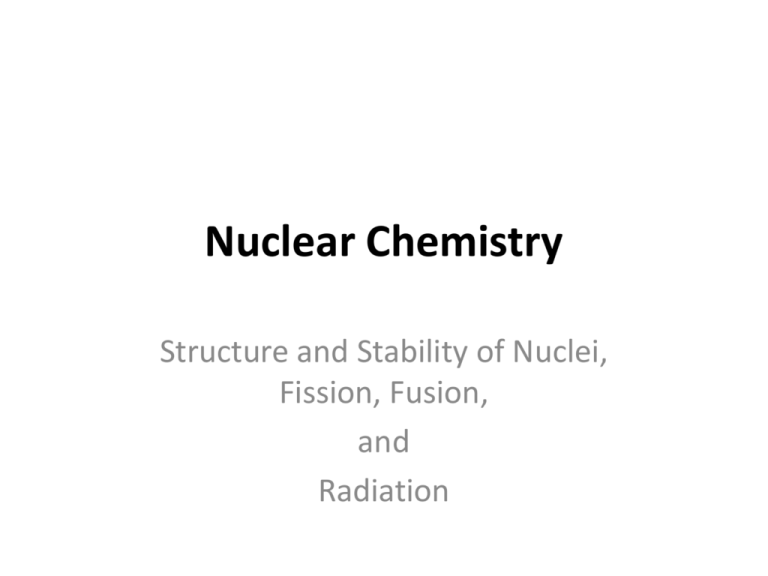
Nuclear Chemistry Structure and Stability of Nuclei, Fission, Fusion, and Radiation Standards 11. Nuclear processes are those in which an atomic nucleus changes, including radioactive decay of naturally occurring and human-made isotopes, nuclear fission, and nuclear fusion. As a basis for understanding this concept: a. Students know protons and neutrons in the nucleus are held together by nuclear forces that overcome the electromagnetic repulsion between the protons. 11. b. Students know the energy release per gram of material is much larger in nuclear fusion or fission reactions than in chemical reactions. The change in mass (calculated by E = mc2 ) is small but significant in nuclear reactions. 11. c. Students know some naturally occurring isotopes of elements are radioactive, as are isotopes formed in nuclear reactions. 11. d. Students know the three most common forms of radioactive decay (alpha, beta, and gamma) and know how the nucleus changes in each type of decay. 11. e. Students know alpha, beta, and gamma radiation produce different amounts and kinds of damage in matter and have different penetrations. 11. f.* Students know how to calculate the amount of a radioactive substance remaining after an integral number of half-lives have passed. 11. g.* Students know protons and neutrons have substructures and consist of particles called quarks. Nuclear Chemistry has to do with an plural of atom’s nucleus nucleus = nuclei What’s a nucleus? Let’s review An atom’s nucleus contains almost all of an atom’s mass, but takes up very little of it’s volume. Subatomic Particles the particles that make up an atom • Protons – high mass, positive charge. Found in nucleus. • Neutrons – high mass, no charge. Found in nucleus. • Electrons – low mass, negative charge. Found orbiting around nucleus. (abbreviated e– ) Comparison of Masses Electron Proton Neutron An Atom Size of atom Size of nucleus 2 protons = He = helium Basic Electrical Charge Laws + and – : Attract (pull together) – and – : Repel (push away) + and + : Repel (push away) Like charges repel and Opposites attract So why don’t the protons in the nucleus fly apart? nuclear is stronger force over short distances electrostatic force is stronger over long distances Key 11 Na Sodium 22.99 Atomic Number •Number of Protons •Number of Electrons (when atom is neutrally charged) •Property unique to each element Key 11 Na Sodium 22.99 Average atomic mass* •Weighted Average number of Protons and Neutrons (approximately) Isotopes When atoms have the same number of protons, but different numbers of neutrons, they are called isotopes. Examples: Carbon-14 has 6 protons and 8 neutrons. Carbon-12 has 6 protons and 6 neutrons. Carbon-14 is found more often in living organisms than in non-living matter. It also undergoes radioactive decay – which is why it is used for fossil dating. Isotopes More Examples: Uranium-238 has 92 protons and 146 neutrons. Uranium-235 has 92 protons and 143 neutrons. Uranium-235 is more rare in nature than Uranium-238, but it also undergoes nuclear chain reactions more easily, which is why small amounts of Uranium-235 are used in nuclear weapons and nuclear power plants. Some isotopes are more stable than others. Which isotope is more abundant? Neon-20 Neon-22 How many neutrons in each? Neon-20 20 – 10 = 10 neutrons Neon-22 22 – 10 = 12 neutrons Which isotope is more abundant? Bromine-79 Bromine-80 How many neutrons in each? Bromine-79 Bromine-80 Lead has two isotopes with the following relative amounts: 80% Lead-207 20% Lead-208 What would the average atomic mass calculate to be? 0.8(207) + 0.2(208) = 207.2 Chlorine has two stable isotopes: ??% Chlorine-35 x 100 –??% Chlorine-37 1 – x What are the relative abundances (in %) of each isotope? -2x = -1.55 x(35) + (1-x)(37) = 35.45 -2 -2 35x – 37x + 37 = 35.45 x = 0.775 -2x + 37 = 35.45 –37 –37 -2x = -1.55 Chlorine has two stable isotopes: 77.5% Chlorine-35 0.775 22.5% Chlorine-37 0.225 What are the relative abundances (in %) of each isotope? -2x = -1.55 x(35) + (1-x)(37) = 35.45 -2 -2 35x – 37x + 37 = 35.45 x = 0.775 -2x + 37 = 35.45 –37 –37 -2x = -1.55 So why don’t the protons in the nucleus fly apart? nuclear is stronger force over short distances electrostatic force is stronger over long distances Sometimes these forces are overcome. Fission – a nucleus breaks apart. (ex. atomic bomb, nuclear power plants, radioactive decay) Fusion – a nucleus merges with another. (ex. the sun, hydrogen bomb, experimental fusion reactors) Both fission and fusion release radiation. It is called radiation because it radiates out. harder to block Symbol Common Types of Radiation 4 2 He α (alpha): helium nucleus at high speed. 0 -1 e β (beta): electron at high speed. 0 0 γ γ (gamma): high energy photon. Symbol 1 0 1 1 0 1 Other Types of Radiation n neutron at high speed. p Proton (or hydrogen nucleus) at high speed. β+ β+ positron at high speed (the antimatter version of an electron). atomic mass number of protons 23 11 Na 22 11 Na We can use conservation of mass and charge to figure out nuclear reactions just like chemical reactions. 238 92 234 90 U 4 2 He + ??? Th 0 -1 e + ??? We can use conservation of mass and charge to figure out nuclear reactions just like chemical reactions. 238 92 234 90 U 4 2 He + Th 0 -1 e + 234 90 Th ??? We can use conservation of mass and charge to figure out nuclear reactions just like chemical reactions. 238 92 234 90 U 4 2 Th 0 -1 He + 234 90 Th e + 234 91 Pa Half-Life • Half-life – how much time has passed when half of the original amount 1 remains. or 50 % 2 • How much of the original remains after 1 two half-lives? or 25 % 4 • How much after three half-lives? 1 or 12.5 % 8 • How much after four half-lives? 1 or 6.25 % 16 Table of Half-Lives Isotope Name Uranium-238 Uranium-235 Carbon-14 Strontium-90 Cobalt-60 Symbol 238 U 92 235 U 92 14 C 6 90 Sr 38 60 Co 27 Half-Life 4.51 × 109 years 7.1 × 108 years 5,730 years 28 years 5.27 years Table of Half-Lives Isotope Name Symbol 234 Th Thorium-234 90 Protactinium-234 23491Pa 218 Po Polonium-218 84 219 Rn Radon-219 86 214 Po Polonium-214 84 Half-Life 24.1 days 6.75 hours 3.08 minutes 4.00 seconds 1.6 × 10-4 seconds As a archaeologist you find a dead rat that contains 0.0009 grams of Carbon-14. A rat that died a year ago has 0.01 grams of Carbon-14. How long ago did the rat die? t½ = 5,730 years 1 0.0009 g = 11.1 0.01 g 1 1 1 1 1 1 2 4 16 32 64 8 1 H.L. 2 H.L. 3 H.L. 4 H.L. 5 H.L. 6 H.L. As a archaeologist you find a dead rat that contains 0.0009 grams of Carbon-14. A rat that died a year ago has 0.01 grams of Carbon-14. How long ago did the rat die? t½ = 5,730 years 3(5,730) = 17,190 years 1 4(5,730) = 22,920 years 11.1 1 1 17,190 – 22,920 years ago 16 8 3 H.L. 4 H.L. Strontium-90 is one of the “fallout” products from atmospheric testing of nuclear weapons. If there were 50,000 grams of Strontium-90 in the U.S. southwest region when the 1963 testing ban began, how much Strontium-90 currently remains? t½ = 28 years 2013 – 1963 = 50 years 50 yr 1.8 half= 28 yr lives 1 1 1 1 1 1 2 4 16 32 64 8 1 H.L. 2 H.L. 3 H.L. 4 H.L. 5 H.L. 6 H.L. Radioactive Decay Formulas -( 1 2 A = A0 e t½ = ln (2) A0 A ln (2) t½ )t t A0 = original amount A = current amount t = current time t½ = half-life ln ( ) A ln ( ) A 3 t = t½ 0 ln (2) Energy-Mass Equivalence Sometimes in nuclear change a small amount of the mass disappears. It has been converted to a large amount of energy according to the formula: 2 E = mc energy = (mass) × (speed of light)2 J = kg × (m/s)2 speed of light: c = 3 × 108 m/s Fission Nuclear Reaction 4 e– in valence shell Which isotope is more abundant? Lead-207 Lead-208 How many neutrons in each? Lead-207 Lead-208

